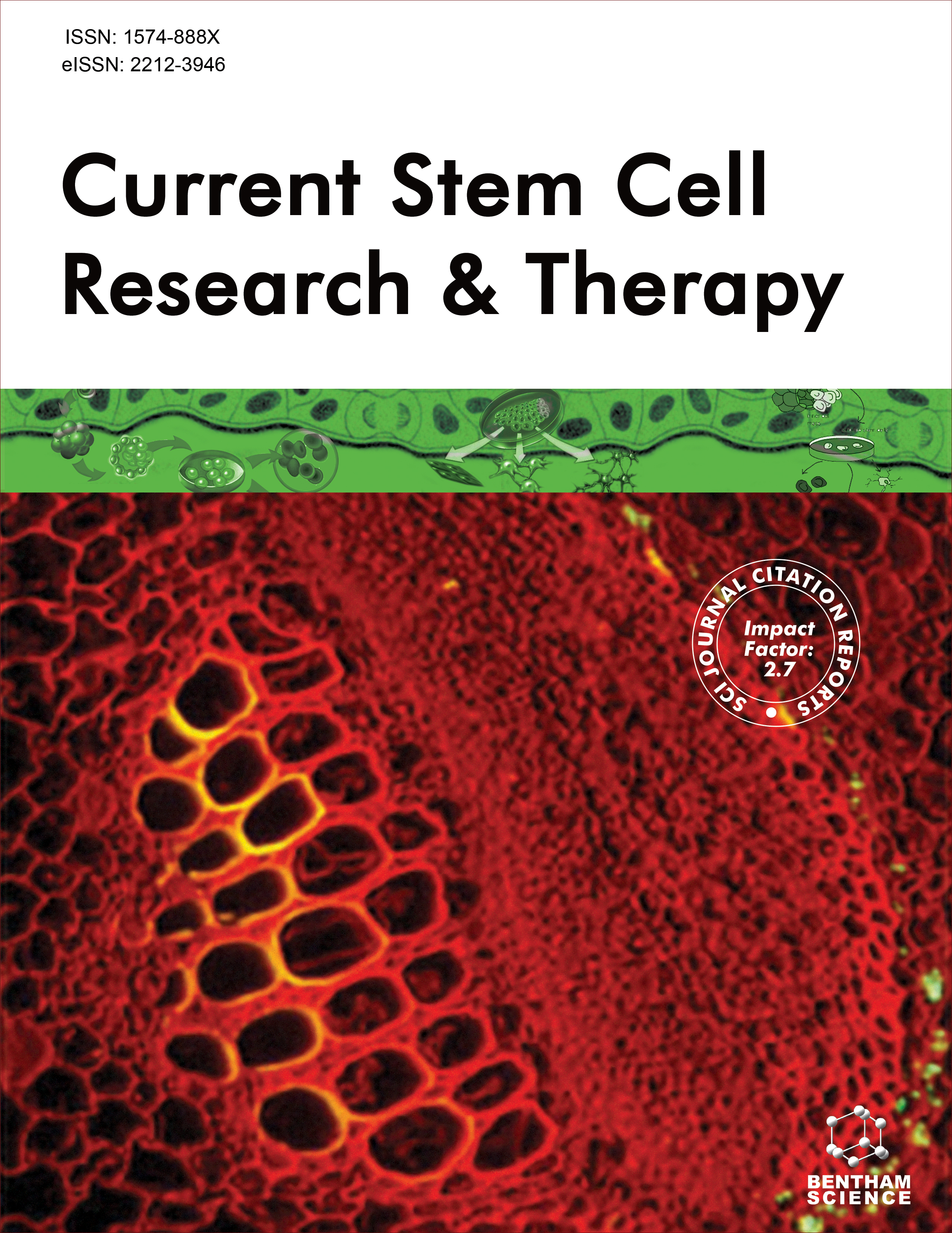- Home
- A-Z Publications
- Current Stem Cell Research & Therapy
- Previous Issues
- Volume 20, Issue 2, 2025
Current Stem Cell Research & Therapy - Volume 20, Issue 2, 2025
Volume 20, Issue 2, 2025
-
-
Efficacy and Safety of Stem Cell Therapy in Alzheimer's Disease: A Review
More LessAuthors: Deepshi Arora, Dhruv Gupta, Deeksha, Yugam Taneja and Ashwani K. DhingraAlzheimer's disease (AD) prevalence is a significant public health concern. Tau tangle buildup and different metabolic abnormalities are the primary neuropathological alterations that lead to this illness. Currently, there is a lack of effective treatment for patients with AD due to the complexity of the disease and the lack of a clear understanding of its aetiology. However, stem cell therapy can potentially be used to replace lost neu Read More
-
-
-
The Role of Stem Cell Therapies in the Treatment of Neurodegenerative Diseases
More LessAuthors: Bindhu Jayaprakash, Maya Savira, Ammar Abdul Razzak Mahmood and Muthu PrasannaCellular replacement therapy and genetic transfer in injured brains provide new pathways for treating human neurological illnesses. Current progress in the field focuses on the production of neurons and glial cells from many types of stem cells, such as embryonic, induced pluripotent, mesenchymal, and neural stem cells. This has led to a significant increase in research on brain transplantation treatments. Extended ne Read More
-
-
-
Insights into the Biological Properties of Prostate Cancer Stem Cells: Implications for Cancer Progression and Therapy
More LessProstate cancer (PCa) is the second prevalent cancer in men. Recent studies have highlighted the critical role of prostate cancer stem cells (PCSCs) in driving tumor initiation and metastasis of the prostate tissue. PCSCs are a rare population of cells in the prostate that possess self-renewal and differentiation capabilities, making them a potential therapeutic target for effective PCa treatment. Therefore, targeting PCSCs might be Read More
-
-
-
Comparative Outcomes of Intravenous, Intranasal, and Intracerebroventricular Transplantation of Human Neural Stem Cells in Mice Model of Ischemic Stroke
More LessAuthors: Mengze Zhang, Yaying Song, Chong Xie and Yangtai GuanBackgroundTransplantation of neural stem cells improves ischemic stroke outcomes in rodent models and is currently in the clinical test stage. However, the optimal delivery route to achieve improved efficacy remains undetermined.ObjectiveThis study aims to evaluate three more clinically feasible delivery routes: intravenous (IV), intranasal (IN), and intracerebroventricular (ICV). We compared the therapeutic efficacies of th Read More
-
-
-
The Renoprotective and Anti-Inflammatory Effects of Human Urine-Derived Stem Cells on Acute Kidney Injury Animals
More LessAuthors: Yuanyuan Kuang, Chenyu Fan, Xiaojun Long, Jiajia Zheng, Yunsi Zeng, Yuhui Wei, Jiasheng Zhang, Shuangjin Yu, Tong Chen, Hehuan Ruan, Yi Wang, Ning Na, Yiming Zhou and Jiang QiuBackgroundAcute Kidney Injury (AKI) is defined as a sudden loss of kidney function, which is often caused by drugs, toxins, and infections. The large spectrum of AKI implies diverse pathophysiological mechanisms. In many cases, AKI can be lethal, and kidney replacement therapy is frequently needed. However, current treatments are not satisfying. Developing novel therapies for AKI is essential. Adult stem cells possess regene Read More
-
-
-
Outcomes of Patients with Heavily Pretreated Relapsed/Refractory Multiple Myeloma Receiving Salvage Cytotoxic Therapy with Supportive Stem Cell Boost
More LessBackgroundMultiple myeloma (MM) is an incurable hematologic malignancy characterized by the neoplastic proliferation of plasma cells, which produce monoclonal immunoglobulin that can cause vital organ damage, subsequently leading to significant morbidity and mortality. Autologous hematopoietic stem cell transplant (ASCT) is the standard-of-care management of eligible patients with newly diagnosed MM. Experts re Read More
-
-
-
The Impact of Amotosalen Photochemical Pathogen Inactivation on Human Platelet Lysate
More LessBackgroundHuman Platelet Lysate (hPL) is a platelet-derived and growth factor-rich supplement for cell culture. It can be prepared from surplus platelet concentrates initially intended for transfusion. Amotosalen-based photochemical pathogen inactivation of platelet concentrates is used in a number of blood establishments worldwide to minimize the risk of pathogen transmission from donor to patient.MethodsThis pathogen i Read More
-
Volumes & issues
-
Volume 20 (2025)
-
Volume 19 (2024)
-
Volume 18 (2023)
-
Volume 17 (2022)
-
Volume 16 (2021)
-
Volume 15 (2020)
-
Volume 14 (2019)
-
Volume 13 (2018)
-
Volume 12 (2017)
-
Volume 11 (2016)
-
Volume 10 (2015)
-
Volume 9 (2014)
-
Volume 8 (2013)
-
Volume 7 (2012)
-
Volume 6 (2011)
-
Volume 5 (2010)
-
Volume 4 (2009)
-
Volume 3 (2008)
-
Volume 2 (2007)
-
Volume 1 (2006)
Most Read This Month
Article
content/journals/cscr
Journal
10
5
false
en


